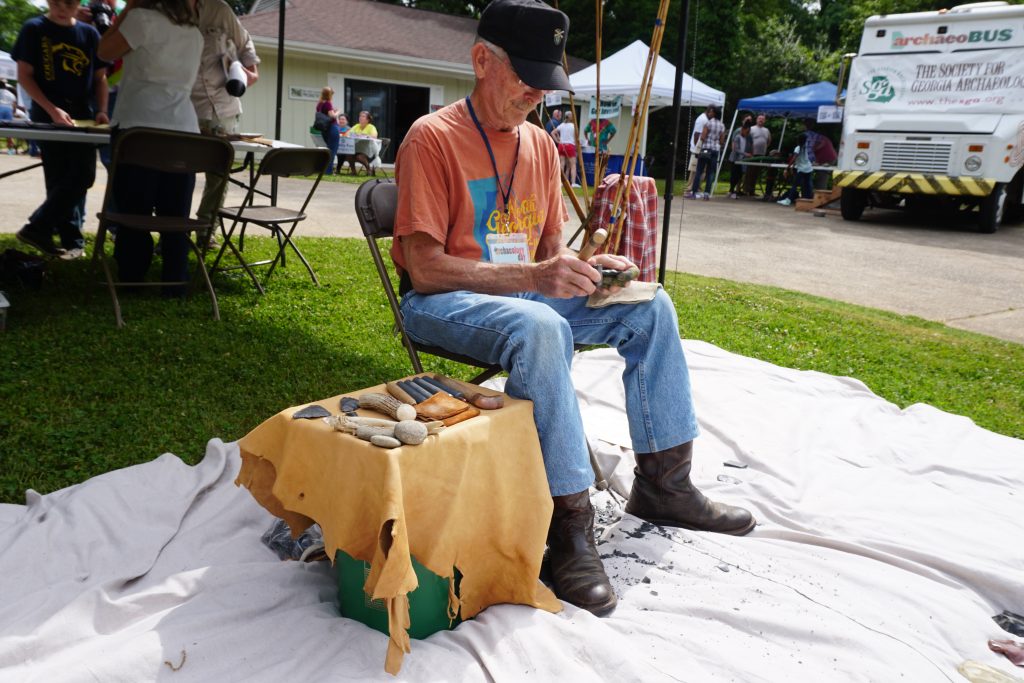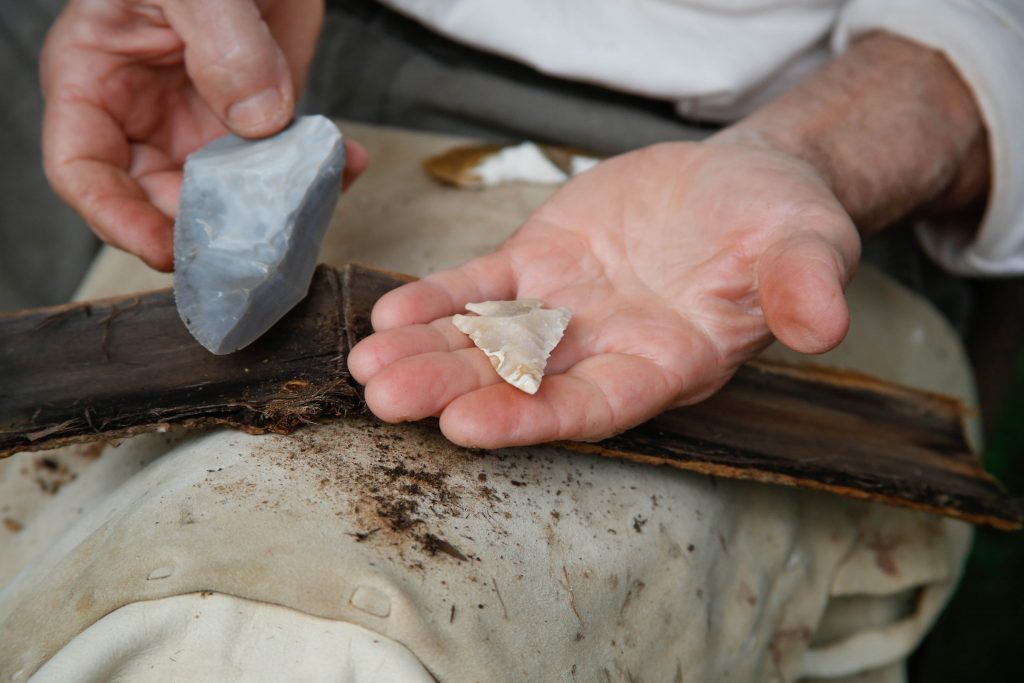
Stone tools, also known as lithic tools, are commonly found on prehistoric sites. There are two types of lithic tools: chipped stone tools and ground stone tools. Ground stone tools are made by pecking, polishing, or grinding one stone with another. Chipped stone tools are made by chipping flakes, or small stone fragments, from a larger piece of stone to shape it and form its razor-sharp edges, point, and base. This process is known as flint knapping.
To learn more, check out this episode of Cherokee Traditions where Noel Grayson discusses the processes and history behind flint knapping.
Video Response Questions:
- What type of tool is flint knapping used to produce?
- How long have Native Americans practiced flint knapping?
- What are the modern versions of Native American stone tools?
- Can you think of tools that you have in your home that stone tools could replace?
- Do you think that flint knappers are artists? Are stone tools an art form? Explain.

Lithic tools are used for all kinds of tasks like hunting, chopping, cutting, hammering, grinding, or hoeing the ground for agricultural needs. Over the thousands of years in North American, tools changed in size and shape as technology changed to adapt to needs. The earliest Native Americans, known as the Paleoindians, hunted with atlatls and darts. They made long, thin dart points to hunt large animals like mastadon and mammoth. Native Americans later used the bow and arrow to hunt smaller prey, so they made smaller arrow points. Dart and arrow points are chipped stone tools. Some other types of chipped stone tools include knives, scrapers, awls, burins and drills. Scrapers are used for cleaning animal hides, butchering meat, and processing plants. Awls are used for shredding plant fibers to use as thread or netting. Burins are used for engraving in materials such as wood, shell, or bone, while drills are used to bore holes in those materials.
Examples of ground stone tools include hammerstones, axes, celts, bannerstones, adzes, and nutting stones. Native Americans even made ground stone game pieces called discoidals, which are round discs, for a popular game known as Chunkey. This game was very important in Native American culture during the Mississippian period (ca. AD 1000 -1550) and the playing space would often be centrally located within a village. To play this game, one player rolls the discoidal while the other players throw sticks with the goal of landing their stick as close as possible to the discoidal’s stopping point. Whoever’s stick lands closest to the discoidal wins the game.
ACTIVITY:
The Cherokee Pheonix produced an article and video on the Cherokee Revitalization of Chunkey.
Article Response Questions:
- After reading the article and watching the video, draw a sketch depicting the game or describe the game in your own words.
- Discuss the value of continuing customs that have been practiced for hundreds or thousands of years. Do you think that Native American customs contribute to our modern American culture?
- Compare Chunkey with games that you have played. Do you think that the cultures that played Chunkey have anything in common with the culture of Georgia today? Explain.
Standards Connector:
| Grade Level | Standard | Description |
| Kindergarten | SSKG1 | Describe the diversity of American culture by explaining the customs and celebrations of various families and communities. |
| Kindergarten | VAK.CN1 | Investigate and discover the personal relationships of artists to community, culture, and the world through making and studying art. b. Recognize the unique contributions of contemporary and/or historical artists and art forms, including Georgia artists. c. Discuss art from a variety of eras and world cultures. |
| Second | SS2H2 | Describe the Georgia Creek and Cherokee cultures of the past in terms of tools, clothing, homes, ways of making a living, and accomplishments. a. Compare and contrast the Georgia Creek and Cherokee cultures of the past to those of Georgians today. |
| Third | SS3H1 | Describe early American Indian cultures and their development in North America. c. Discuss how American Indians continue to contribute to American life (e.g., arts, literature). |
These standards of excellence were sourced from the Georgia Department of Education web page at https://www.georgiastandards.org/Georgia-Standards/Pages/default.aspx
